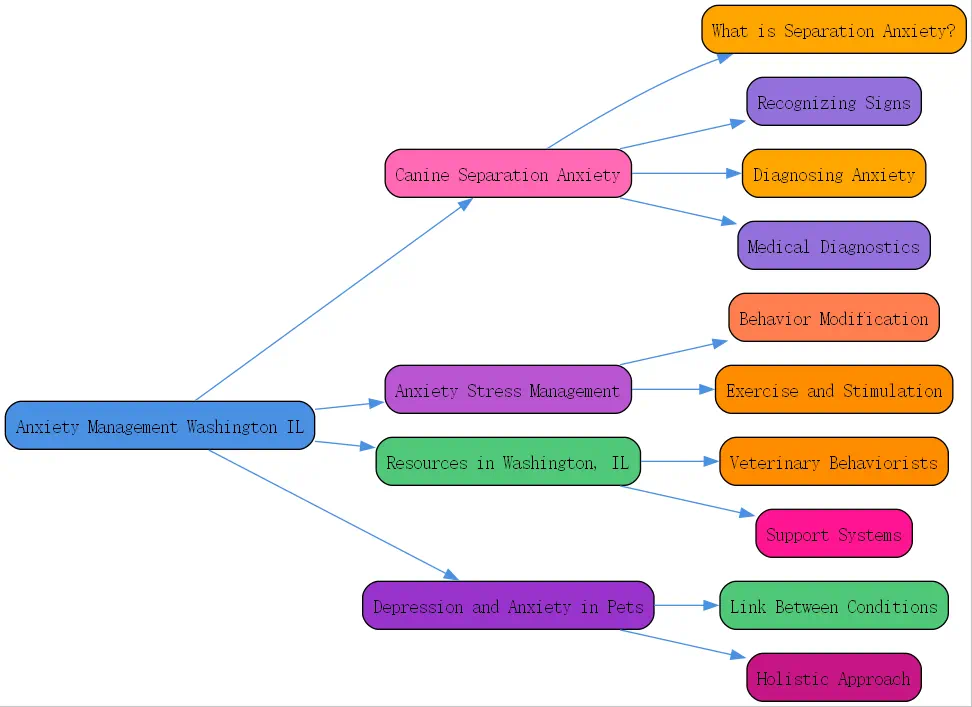Anxiety Management in Washington, IL: Understanding and Addressing Canine Separation Anxiety

Living with a dog brings immense joy, but sometimes challenges arise that tug at our heartstrings. One such challenge, often perplexing and distressing for pet parents, is separation anxiety. Here at BrainTalking, while we often delve into the human psyche, the principles of understanding and managing anxiety have parallels in the animal world. Witnessing your beloved canine companion’s distress when left alone is heartbreaking. Let’s explore this common issue and how effective anxiety management can bring peace back to your home.
What is Separation Anxiety in Dogs?
Separation anxiety isn’t just a bit of whining when you grab your keys; it’s a genuine panic disorder triggered by isolation or separation from their primary attachment figure 閳?usually you. Imagine the intense fear and distress your dog might feel, translating into behaviors that can leave your home in disarray and your heart aching. This isn’t spite or bad behavior; it’s a cry for help stemming from deep-seated anxiety.
The prevalence of this condition is surprisingly high. Research suggests anywhere from a concerning 6% to a staggering 50% of pet dogs experience some form of separation anxiety. This wide range highlights how common this struggle is, impacting countless canine lives and the humans who love them. Understanding its roots is key to effective anxiety management washington il.
Several factors can contribute to a dog developing separation anxiety. Genetics certainly play a role, with some breeds potentially being more predisposed. A dog’s early life experiences, such as being acquired from a shelter versus a breeder, can influence their vulnerability. Environmental factors are also crucial; dogs in households with single adults or multiple female adults, or those who didn’t get enough exercise during key developmental stages, might face a higher risk.
Recognizing the Signs of Anxiety in Dogs
Identifying separation anxiety requires keen observation, as signs range from obvious destruction to subtle shifts in behavior. The most commonly recognized symptoms often involve destruction 閳?chewing furniture, scratching doors, or shredding belongings. Excessive vocalization, like persistent howling, barking, or whining when left alone, is another telltale sign. House soiling (urination or defecation) despite being otherwise house-trained is also frequently reported by distressed owners.
However, it’s crucial not to overlook the quieter indicators of distress. Subtle signs often provide the most poignant glimpse into a dog’s anxious state. Increased thirst upon your return, excessive panting even when not physically exerted, restless pacing back and forth, or extreme drooling (hypersalivation) can all signal underlying anxiety related to your absence. Recognizing these nuances is vital for early intervention.
Differentiating true separation anxiety from other behavioral issues is paramount for effective treatment. Is the destruction due to boredom or lack of appropriate chew toys? Is the barking triggered by external stimuli like passersby? Is the house soiling a medical issue or incomplete training? Pinpointing that the behaviors only occur during absence or separation is a key diagnostic step.
Diagnosing Canine Separation Anxiety
A proper diagnosis is more than just observing destructive behavior; it’s a careful process of elimination and pattern recognition. It typically begins with a detailed behavioral history. A veterinarian or behavior specialist will ask questions about the dog’s background, daily routine, the specific behaviors exhibited, and when they occur. Understanding the triggers 閳?is it any absence, or only long ones? Does pre-departure anxiety start when you pick up your keys? 閳?lays the groundwork.
Direct observation, often via video recording, is invaluable. Many hallmark signs of separation anxiety manifest within the first 10 to 20 minutes after the owner leaves. Watching this footage allows professionals to see the pacing, panting, vocalizing, or destructive acts firsthand, confirming the link between the owner’s absence and the dog’s distress. It helps differentiate anxiety from other issues like boredom, which might develop later during the absence.
Crucially, diagnosis involves ruling out other potential causes for the observed behaviors. As mentioned, destruction might be teething in puppies or lack of enrichment. Vocalization could be territorial barking or response to noises. House soiling, in particular, requires careful scrutiny. Is it true separation-induced panic, or could it be urine marking, cognitive decline in older dogs, insufficient house training, excitement urination, or even a response to schedule changes or dietary upset? Patience and thorough investigation are key.
Medical Diagnostics for Anxiety Management
Before definitively labeling a behavior as separation anxiety, a comprehensive medical workup is essential. Many underlying health conditions can cause or worsen anxiety-like symptoms, including house soiling or restlessness. Ruling these out ensures that treatment targets the actual problem, whether purely behavioral, purely medical, or a combination. This step is fundamental to responsible anxiety management washington il.
Veterinarians typically start with baseline blood tests. A general chemistry panel assesses organ function (like liver and kidneys), blood sugar, and protein levels, looking for metabolic issues. A complete blood count (CBC) examines red and white blood cells and platelets, helping to detect infection, inflammation, or anemia. Electrolyte levels are checked to ensure proper hydration and nerve function, as imbalances can affect behavior.
Thyroid function is often assessed by measuring thyroxin (T4) levels. Hypothyroidism (low thyroid hormone) can sometimes contribute to lethargy or behavioral changes that might be confused with anxiety or depression. A fecal exam screens for intestinal parasites, which can cause gastrointestinal upset leading to house soiling. Similarly, a urinalysis checks for urinary tract infections (UTIs), crystals, or other kidney/bladder issues that could cause inappropriate urination or discomfort manifesting as restlessness.
Finally, depending on the dog’s history and symptoms, a neurological exam might be recommended. This assesses reflexes, coordination, and sensory responses to rule out underlying neurological conditions that could impact behavior, such as cognitive dysfunction syndrome (canine dementia) or brain tumors, especially in older pets. Addressing any medical findings is the first step towards effective anxiety treatment.
Anxiety Stress Management Techniques for Dogs
Once medical issues are ruled out or addressed, managing separation anxiety primarily involves behavior modification, often combined with environmental management and, sometimes, medication prescribed by a vet. These anxiety stress management techniques require patience and consistency but can significantly improve a dog’s quality of life.
Behavior Modification Techniques

The core of treating separation anxiety often involves two key techniques: desensitization and counter-conditioning. Desensitization means gradually acclimating the dog to being alone, starting with incredibly short absences (seconds!) and slowly increasing the duration only as the dog remains calm. This process must move at the dog’s pace, never pushing them to the point of anxiety.
Counter-conditioning aims to change the dog’s emotional response to being alone from fear to anticipation of something pleasant. This often involves providing a high-value, long-lasting treat (like a puzzle toy stuffed with food) only when the owner leaves. The goal is for the dog to associate departures with this positive experience, reducing pre-departure anxiety cues.
Creating a safe, comfortable den-like space can also help some dogs feel more secure. This might be a crate (if crate-trained positively) or a specific room with comfortable bedding, water, and safe toys. It’s crucial this space is never used for punishment and is always associated with positive experiences. Management also includes avoiding absences longer than the dog can tolerate during the training period.
The Role of Exercise and Mental Stimulation
Physical exercise and mental engagement are critical components of any anxiety stress management techniques plan. Adequate physical activity helps burn excess energy that might otherwise fuel anxious behaviors. Daily walks, runs, or vigorous play sessions tailored to the dog’s breed, age, and health are essential. Exercise also releases endorphins, which have mood-boosting effects.
Mental stimulation is equally important for preventing boredom and anxiety. Engaging a dog’s brain through puzzle toys, food-dispensing toys, learning new tricks, or participating in dog sports like nose work can provide necessary enrichment. Short, positive training sessions throughout the day reinforce good behavior and strengthen the human-animal bond, further building confidence.
Establishing and maintaining a predictable daily routine can also provide a sense of security for anxious dogs. Regular feeding times, consistent walk schedules, predictable playtimes, and clear cues for departures and arrivals help the dog understand the rhythm of the day, reducing uncertainty which can exacerbate anxiety. Consistency is key across all aspects of management.
Anxiety Management Course and Resources in Washington, IL
Navigating separation anxiety can feel overwhelming, but you don’t have to do it alone. Seeking professional guidance and utilizing available resources, including those potentially available for anxiety management washington il, is often the most effective path forward.
Consulting with Veterinary Behaviorists
For moderate to severe cases, consulting a board-certified veterinary behaviorist (DACVB) or a veterinarian with a special interest and additional training in behavior is highly recommended. These professionals have the expertise to accurately diagnose the issue, rule out contributing medical factors, and develop a comprehensive, tailored treatment plan specific to your dog’s needs and your lifestyle.
Treatment plans often combine the behavior modification techniques discussed earlier (desensitization, counter-conditioning) with specific management strategies. In some cases, particularly severe anxiety that hinders learning or causes significant distress or self-injury, medication may be recommended as a tool alongside behavior modification. Anti-anxiety medications can help lower the dog’s baseline anxiety, making them more receptive to training.
Finding a qualified professional is key. Your primary veterinarian can be a starting point for referral. Look for individuals who use positive reinforcement methods and have experience specifically with separation anxiety. A structured anxiety management course guided by professionals can provide invaluable support.
Support Systems and Community Resources
Beyond professional consultations, look for local resources. Obedience training clubs or facilities in or near Washington, IL might offer classes focused on confidence-building or even specialized courses tackling anxiety issues. Participating in positive reinforcement-based training can strengthen your bond and improve communication with your dog.
Online communities and forums dedicated to separation anxiety can also provide peer support. Connecting with other pet owners who understand the daily challenges can be incredibly helpful, offering shared experiences and encouragement. Remember to vet any advice received online with your veterinarian or behavior consultant.
The most critical elements for success are patience and consistency. Managing separation anxiety is typically a long-term commitment, not a quick fix. There will be progress and likely some setbacks. Celebrating small victories and sticking with the plan, even when it feels slow, is essential for helping your dog learn to feel safe and secure when alone.
Depression and Anxiety Management for Pets
Just like humans, pets can experience complex emotional states, and sometimes anxiety and depression can occur together or exhibit overlapping signs. Recognizing this potential link is important for holistic depression and anxiety management in our animal companions.
Recognizing the Link between Depression and Anxiety
While separation anxiety is characterized by panic related to being alone, depression in dogs might manifest as generalized lethargy, loss of interest in previously enjoyed activities (like play or walks), changes in appetite or sleep patterns, and social withdrawal. Sometimes, chronic, unresolved anxiety can lead to a state resembling depression due to prolonged stress.
Conversely, a dog suffering from underlying depression might be more susceptible to developing anxiety disorders, including separation anxiety, as their overall emotional resilience is lower. Identifying the primary issue, or recognizing that both may be present, is crucial for effective intervention. Careful observation of behavior patterns both when you are home and away is key.
Addressing both conditions requires a comprehensive approach. Treatment plans may need to incorporate strategies aimed at boosting mood and engagement (like increased enrichment, positive social interaction, exploring new environments safely) alongside specific anxiety-reducing protocols. Again, professional guidance is invaluable here.
Holistic Approach

A holistic view considers the dog’s physical health, mental well-being, environment, and daily routine. Effective depression and anxiety management means looking beyond just the problematic behaviors to understand the dog’s overall state. This includes ensuring proper nutrition, adequate exercise, sufficient mental stimulation, positive social interactions, and a predictable, secure environment.
Sometimes, addressing an underlying medical condition causing pain or discomfort can alleviate symptoms mistaken for depression or anxiety. Similarly, improving environmental enrichment or adjusting routines can significantly impact a dog’s mood and stress levels. Working closely with your veterinarian and potentially a behavior professional ensures all aspects of your dog’s well-being are considered.
Key Takeaways for Managing Canine Anxiety:
- Understand the Condition: Separation anxiety is a panic disorder, not bad behavior.
- Observe Carefully: Note both obvious (destruction, vocalization) and subtle (panting, pacing) signs that occur only during absence.
- Rule Out Medical Issues: A thorough veterinary checkup is essential before starting behavioral treatment.
- Use Behavior Modification: Implement desensitization and counter-conditioning patiently and consistently.
- Provide Enrichment: Ensure adequate daily physical exercise and mental stimulation.
- Maintain Routine: Predictable schedules can reduce overall stress.
- Seek Professional Help: Consult veterinarians or behaviorists for diagnosis and tailored plans. Consider an anxiety management course.
- Be Patient: Progress takes time and commitment.
Q: How long does it take to manage separation anxiety in dogs?
A: There’s no single timeline for managing separation anxiety, as it varies greatly depending on several factors. The severity of the anxiety, the dog’s individual temperament and learning history, how long the behavior has been occurring, and crucially, the owner’s consistency and ability to implement the management and training plan all play significant roles.




